(完整版)2019年英语高考全国1卷word版试卷+答案
- 格式:doc
- 大小:41.84 KB
- 文档页数:13
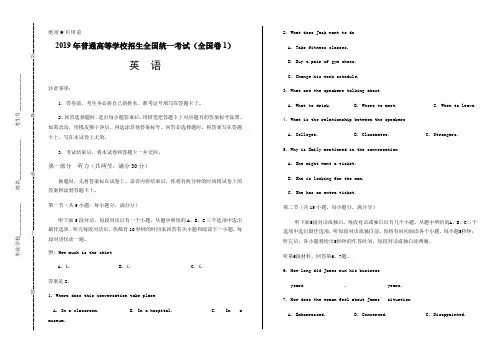
绝密★启用前 2019年普通高等学校招生全国统一考试(全国卷1)英 语注意事项:1.答卷前,考生务必将自己的姓名、准考证号填写在答题卡上。
2.回答选择题时,选出每小题答案后,用铅笔把答题卡上对应题目的答案标号涂黑。
如需改动,用橡皮擦干净后,再选涂其他答案标号。
回答非选择题时,将答案写在答题卡上,写在本试卷上无效。
3.考试结束后,将本试卷和答题卡一并交回。
第一部分 听力(共两节,满分30分)做题时,先将答案标在试卷上。
录音内容结束后,你将有两分钟的时间将试卷上的答案转涂到答题卡上。
第一节(共5小题;每小题分,满分分)听下面5段对话。
每段对话后有一个小题,从题中所给的A 、B 、C 三个选项中选出最佳选项。
听完每段对话后,你都有10秒钟的时间来回答有关小题和阅读下一小题。
每段对话仅读一遍。
例:How much is the shirtA. £.B. £.C. £.答案是C 。
1. Where does this conversation take place A. In a classroom.B. In a hospital.C.Inamuseum.2. What does Jack want to do A. Take fitness classes. B. Buy a pair of gym shoes. C. Change his work schedule.3. What are the speakers talking about A. What to drink.B. Where to meet.C. When to leave.4. What is the relationship between the speakers A. Colleges.B. Classmates.C. Strangers.5. Why is Emily mentioned in the conversation A. She might want a ticket. B. She is looking for the man. C. She has an extra ticket. 第二节(共15小题,每小题分,满分分)听下面5段对话或独白。
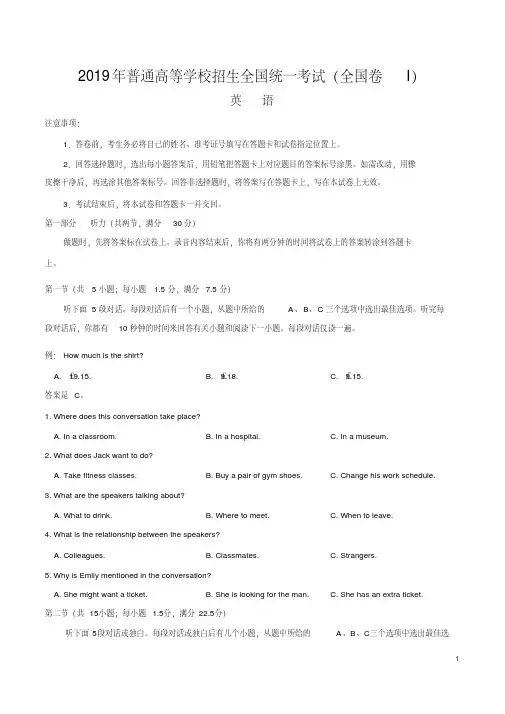
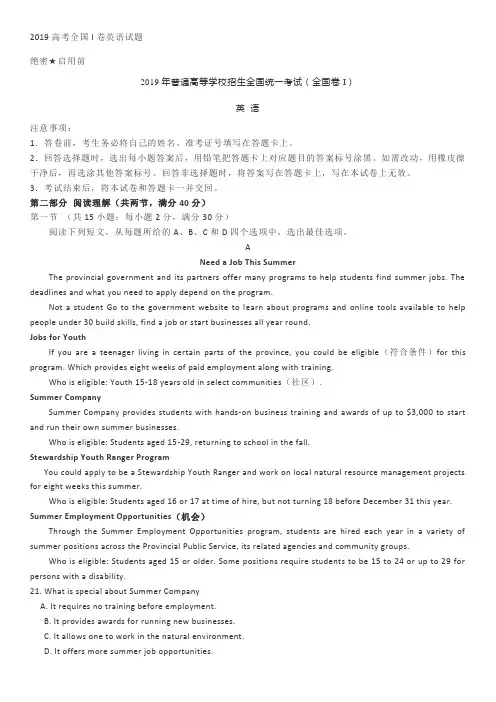
2019高考全国I卷英语试题绝密★启用前2019年普通高等学校招生全国统一考试(全国卷I)英语注意事项:1.答卷前,考生务必将自己的姓名、准考证号填写在答题卡上。
2.回答选择题时,选出每小题答案后,用铅笔把答题卡上对应题目的答案标号涂黑。
如需改动,用橡皮擦干净后,再选涂其他答案标号。
回答非选择题时,将答案写在答题卡上,写在本试卷上无效。
3.考试结束后,将本试卷和答题卡一并交回。
第二部分阅读理解(共两节,满分40分)第一节(共15小题;每小题2分,满分30分)阅读下列短文,从每题所给的A、B、C和D四个选项中,选出最佳选项。
ANeed a Job This SummerThe provincial government and its partners offer many programs to help students find summer jobs. The deadlines and what you need to apply depend on the program.Not a student Go to the government website to learn about programs and online tools available to help people under 30 build skills, find a job or start businesses all year round.Jobs for YouthIf you are a teenager living in certain parts of the province, you could be eligible(符合条件)for this program. Which provides eight weeks of paid employment along with training.Who is eligible: Youth 15-18 years old in select communities(社区).Summer CompanySummer Company provides students with hands-on business training and awards of up to $3,000 to start and run their own summer businesses.Who is eligible: Students aged 15-29, returning to school in the fall.Stewardship Youth Ranger ProgramYou could apply to be a Stewardship Youth Ranger and work on local natural resource management projects for eight weeks this summer.Who is eligible: Students aged 16 or 17 at time of hire, but not turning 18 before December 31 this year. Summer Employment Opportunities(机会)Through the Summer Employment Opportunities program, students are hired each year in a variety of summer positions across the Provincial Public Service, its related agencies and community groups.Who is eligible: Students aged 15 or older. Some positions require students to be 15 to 24 or up to 29 for persons with a disability.21. What is special about Summer CompanyA. It requires no training before employment.B. It provides awards for running new businesses.C. It allows one to work in the natural environment.D. It offers more summer job opportunities.22. What is the age range required by Stewardship Youth Ranger Program. . . .23. Which program favors the disabledA. Jobs for Youth.B. Summer Company.C. Stewardship Youth Ranger Program.D. Summer Employment Opportunities.BFor Canaan Elementary’s second grade in Patchogue, .,today is speech day ,and right now it’s Chris Palaez’s turn. The 8-year-old is the joker of the class. With shining dark eyes, he seems like the of kid who would enjoy public speaking.But he’s nervous.“I’m here to tell you today why you should … should…”Chris trips on the“-ld,”a. pronunciation difficulty for many non-native English speakers. His teacher ,Thomas Whaley ,is next to him, whispering support.“…Vote for …me …”Except for some stumbles, Chris is doing amazingly well. When he brings his speech to a nice conclusion ,Whaley invites the rest of the class to praise him.A son of immigrants, Chris stared learning English a little over three years ago. Whaley recalls(回想起)how at the beginning of the year,when called upon to read,Chris would excuse himself to go to the bathroom.Learning English as a second language can be a painful experience. What you need is a great teacher who lets you make mistakes. “It takes a lot for any student,” Whaley explains,“especially for a student who is learning English as their new language,to feel confident enough to say,‘I don’t know,but I want to know.’”Whaley got the idea of this second-grade presidential campaign project when he asked the children one day to raise their hands if they thought they could never be a president. The answer broke his heart. Whaley says the project is about more than just learning to read and speak in public. He wants these kids to learn to boast(夸耀)about themselves.“Boasting about yourself,and your best qualities,” Whaley says,“is very difficult for a child who came into the classroom not feeling confident.”24. What made Chris nervousA. Telling a story.B. Making a speech.C. Taking a test.D. Answering a question.25. What does the underlined word “stumbles” in paragraph 2 refer toA. Improper pauses.B. Bad manners.C. Spelling mistakes.D. Silly jokes.26. We can infer that the purpose of Whaley’s project is to _________.A. help students see their own strengthsB. assess students’ public speaking skillsC. prepare students for their future jobsD. inspire students’ love for politics27. Which of the following best describes Whaley as a teacherA. Humorous.B. Ambitious.C. Caring.D. Demanding.CAs data and identity theft becomes more and more common, the market is growing for biometric(生物测量)technologies—like fingerprint scans—to keep others out of private e-spaces. At present, these technologies are still expensive, though.Researchers from Georgia Tech say that they have come up with a low-cost device(装置)that gets around this problem: a smart keyboard. This smart keyboard precisely measures the cadence(节奏)with which one types and the pressure fingers apply to each key. The keyboard could offer a strong layer of security by analyzing things like the force of a user's typing and the time between key presses. These patterns are unique to each person. Thus, the keyboard can determine people's identities, and by extension, whether they should be given access to the computer it's connected to—regardless of whether someone gets the password right.It also doesn't require a new type of technology that people aren't already familiar with. Everybody uses a keyboard and everybody types differently.In a study describing the technology, the researchers had 100 volunteers type the wo rd “touch”four times using the smart keyboard. Data collected from the device could be used to recognize different participants based on how they typed, with very low error rates. The researchers say that the keyboard should be pretty straightforward to commercialize and is mostly made of inexpensive, plastic-like parts. The team hopes to make it to market in the near future.28. Why do the researchers develop the smart keyboardA. To reduce pressure on keys.B. To improve accuracy in typingC. To replace the password system.D. To cut the cost of e-space protection.29. What makes the invention of the smart keyboard possibleA. Computers are much easier to operate.B. Fingerprint scanning techniques develop fast.C. Typing patterns vary from person to person.D. Data security measures are guaranteed.30. What do the researchers expect of the smart keyboardA. It'll be environment-friendly.B. It'll reach consumers soon.C. It'll be made of plastics.D. It'll help speed up typing.31. Where is this text most likely fromA. A diary. guidebook C. A novel. D. A magazine.DDuring the rosy years of elementary school(小学), I enjoyed sharing my dolls and jokes, which allowed me to keep my high social status. I was the queen of the playground. Then came my tweens and teens, and mean girls and cool kids. They rose in the ranks not by being friendly but by smoking cigarettes, breaking rules and playing jokes on others, among whom I soon found myself.Popularity is a well-explored subject in social psychology. Mitch Prinstein, a professor of clinical psychology sorts the popular into two categories: the likable and the status seekers. The likables’ plays-well-with-others qualities strengthen schoolyard friendships, jump-start interpersonal skills and, when tapped early, are employed ever after in life and work. Then there’s the kind of popularity that appears in adolescence: status born of power and even dishonorable behavior.Enviable as the cool kids may have seemed, Dr. Prinstei n’s studies show unpleasant consequences. Those who were highest in status in high school, as well as those least liked in elementary school, are “most likely to engage(从事)in dangerous and risky behavior.”In one study, Dr. Prinstein examined the two types of popularity in 235 adolescents, scoring the least liked, the most liked and the highest in status based on student surveys(调查研究). “We found that the least well-liked teens had become more aggressive over time toward their classmates. But so had those wh o werehigh in status. It clearly showed that while likability can lead to healthy adjustment, high status has just the opposite effect on us."Dr. Prinstein has also found that the qualities that made the neighbors want you on a play date-sharing, kindness, openness — carry over to later years and make you better able to relate and connect with others.In analyzing his and other research,Dr. Prinstein came to another conclusion: Not only is likability related to positive life outcomes, but it is also responsible for those outcomes, too. "Being liked creates opportunities for learning and for new kinds of life experiences that help somebody gain an advantage, ” he said.32. What sort of girl was the author in her early years of elementary schoolA. Unkind.B. Lonely.C. Generous.D. Cool.is the second paragraph mainly aboutA. The classification of the popular.B. The characteristics of adolescents.C. The importance of interpersonal skills.D. The causes of dishonorable behavior.34. What did Dr. Prinstein’s study find about the most liked kidsA. They appeared to be aggressive.B. They tended to be more adaptable.C. They enjoyed the highest status.D. They performed well academically.35. What is the best title for the textA. Be Nice-You Won’t F inish LastB. The Higher the Status, the BetterC. Be the Best-You Can Make ItD. More Self-Control, Less Aggressiveness第二节(共5小题;每小题2分,满分10分)根据短文内容,从短文后的选项中选出能填入空白处的最佳选项。
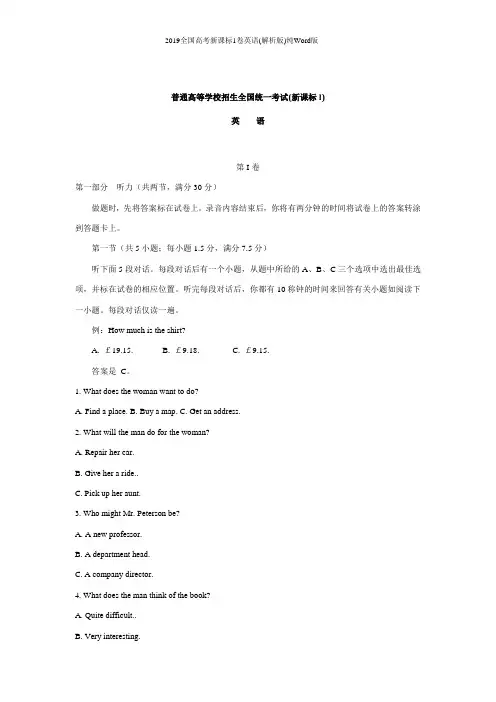
普通高等学校招生全国统一考试(新课标I)英语第I卷第一部分听力(共两节,满分30分)做题时,先将答案标在试卷上。
录音内容结束后,你将有两分钟的时间将试卷上的答案转涂到答题卡上。
第一节(共5小题;每小题1.5分,满分7.5分)听下面5段对话。
每段对话后有一个小题,从题中所给的A、B、C三个选项中选出最佳选项,并标在试卷的相应位置。
听完每段对话后,你都有10称钟的时间来回答有关小题如阅读下一小题。
每段对话仅读一遍。
例:How much is the shirt?A. £19.15.B. £9.18.C. £9.15.答案是C。
1. What does the woman want to do?A. Find a place.B. Buy a map.C. Get an address.2. What will the man do for the woman?A. Repair her car.B. Give her a ride..C. Pick up her aunt.3. Who might Mr. Peterson be?A. A new professor.B. A department head.C. A company director.4. What does the man think of the book?A. Quite difficult..B. Very interesting.C. Too simple.5. What are the speakers talking about?A. Weather.B. Clothes.C. News.第二节(共15小题;每小题1.5分,满分22.5分)听下面5段对话或独白。
每段对话或独白后有几个小题,从题中所给的A、B、C三个选项中选出最佳选项,并标在试卷的相应位置。
听每段对话或独白前,你将有时间阅读各个小题,每小题5秒钟;听完后,各小题将给出5秒钟的作答时间。
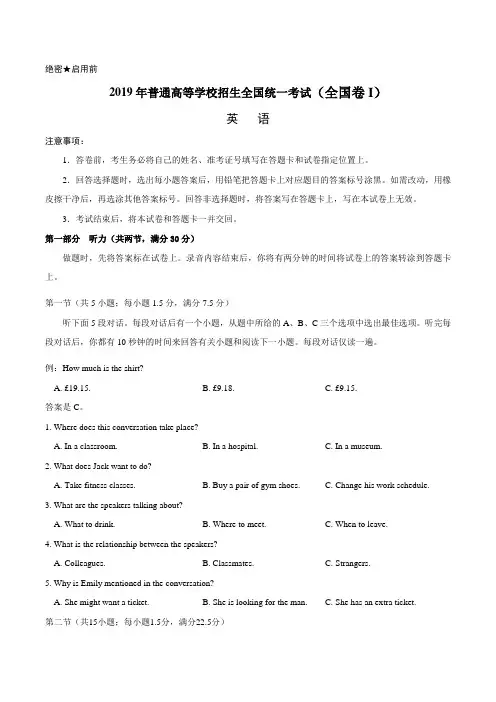
绝密★启用前2019年普通高等学校招生全国统一考试(全国卷I)英语注意事项:1.答卷前,考生务必将自己的姓名、准考证号填写在答题卡和试卷指定位置上。
2.回答选择题时,选出每小题答案后,用铅笔把答题卡上对应题目的答案标号涂黑。
如需改动,用橡皮擦干净后,再选涂其他答案标号。
回答非选择题时,将答案写在答题卡上,写在本试卷上无效。
3.考试结束后,将本试卷和答题卡一并交回。
第一部分听力(共两节,满分30分)做题时,先将答案标在试卷上。
录音内容结束后,你将有两分钟的时间将试卷上的答案转涂到答题卡上。
第一节(共5小题;每小题1.5分,满分7.5分)听下面5段对话。
每段对话后有一个小题,从题中所给的A、B、C三个选项中选出最佳选项。
听完每段对话后,你都有10秒钟的时间来回答有关小题和阅读下一小题。
每段对话仅读一遍。
例:How much is the shirt?A. £19.15.B. £9.18.C. £9.15.答案是C。
1. Where does this conversation take place?A. In a classroom.B. In a hospital.C. In a museum.2. What does Jack want to do?A. Take fitness classes.B. Buy a pair of gym shoes.C. Change his work schedule.3. What are the speakers talking about?A. What to drink.B. Where to meet.C. When to leave.4. What is the relationship between the speakers?A. Colleagues.B. Classmates.C. Strangers.5. Why is Emily mentioned in the conversation?A. She might want a ticket.B. She is looking for the man.C. She has an extra ticket.第二节(共15小题;每小题1.5分,满分22.5分)听下面5段对话或独白。
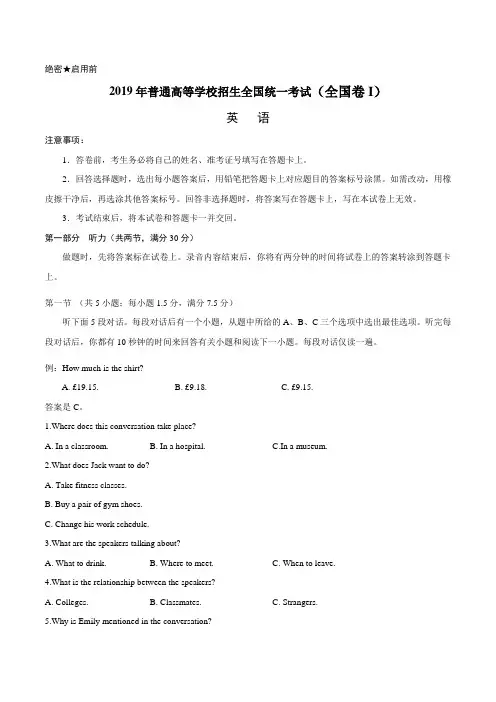
绝密★启用前2019年普通高等学校招生全国统一考试(全国卷I)英语注意事项:1.答卷前,考生务必将自己的姓名、准考证号填写在答题卡上。
2.回答选择题时,选出每小题答案后,用铅笔把答题卡上对应题目的答案标号涂黑。
如需改动,用橡皮擦干净后,再选涂其他答案标号。
回答非选择题时,将答案写在答题卡上,写在本试卷上无效。
3.考试结束后,将本试卷和答题卡一并交回。
第一部分听力(共两节,满分30分)做题时,先将答案标在试卷上。
录音内容结束后,你将有两分钟的时间将试卷上的答案转涂到答题卡上。
第一节(共5小题;每小题1.5分,满分7.5分)听下面5段对话。
每段对话后有一个小题,从题中所给的A、B、C三个选项中选出最佳选项。
听完每段对话后,你都有10秒钟的时间来回答有关小题和阅读下一小题。
每段对话仅读一遍。
例:How much is the shirt?A. £19.15.B. £9.18.C. £9.15.答案是C。
1.Where does this conversation take place?A. In a classroom.B. In a hospital.C.In a museum.2.What does Jack want to do?A. Take fitness classes.B. Buy a pair of gym shoes.C. Change his work schedule.3.What are the speakers talking about?A. What to drink.B. Where to meet.C. When to leave.4.What is the relationship between the speakers?A. Colleges.B. Classmates.C. Strangers.5.Why is Emily mentioned in the conversation?A. She might want a ticket.B. She is looking for the man.C. She has an extra ticket.第二节(共15小题,每小题1.5分,满分22.5分)听下面5段对话或独白。
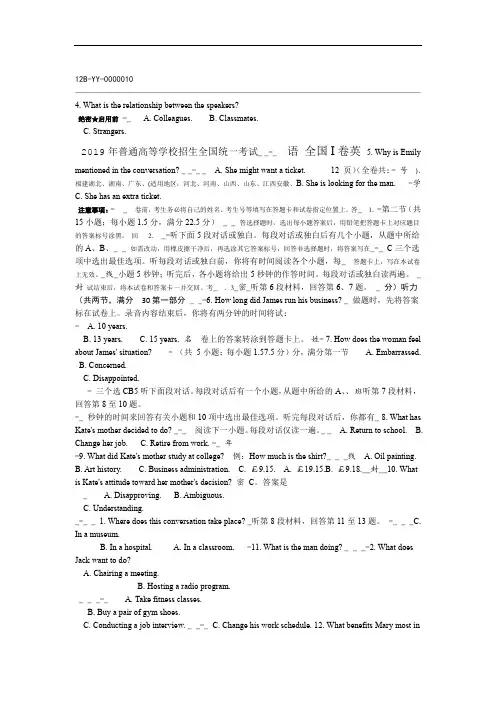
12B-YY-00000104. What is the relationship between the speakers?绝密★启用前 -_ A. Colleagues. B. Classmates.C. Strangers.2019年普通高等学校招生全国统一考试_ _-_ 语全国I卷英 5. Why is Emily mentioned in the conversation? _ _-_ _ A. She might want a ticket. 12 页)(全卷共:- 号)、福建湖北、湖南、广东、(适用地区:河北、河南、山西、山东、江西安徽、B. She is looking for the man. -学C. She has an extra ticket.注意事项:- _ 卷前,考生务必将自己的姓名、考生号等填写在答题卡和试卷指定位置上。
答_1.-第二节(共15小题;每小题1.5分,满分22.5分)_ _ 答选择题时,选出每小题答案后,用铅笔把答题卡上对应题目的答案标号涂黑。
回2._-听下面5段对话或独白。
每段对话或独白后有几个小题,从题中所给的A、B、_ _ 如需改动,用橡皮擦干净后,再选涂其它答案标号,回答非选择题时,将答案写在_-_ C三个选项中选出最佳选项。
听每段对话或独白前,你将有时间阅读各个小题,每_ 答题卡上,写在本试卷上无效。
_线_小题5秒钟;听完后,各小题将给出5秒钟的作答时间。
每段对话或独白读两遍。
_封试结束后,将本试卷和答案卡一并交回。
考_.3_密_听第6段材料,回答第6、7题。
_分)听力(共两节,满分30第一部分 _ _-6. How long did James run his business? _ 做题时,先将答案标在试卷上。
录音内容结束后,你将有两分钟的时间将试:- A. 10 years.B. 13 years.C. 15 years. 名卷上的答案转涂到答题卡上。
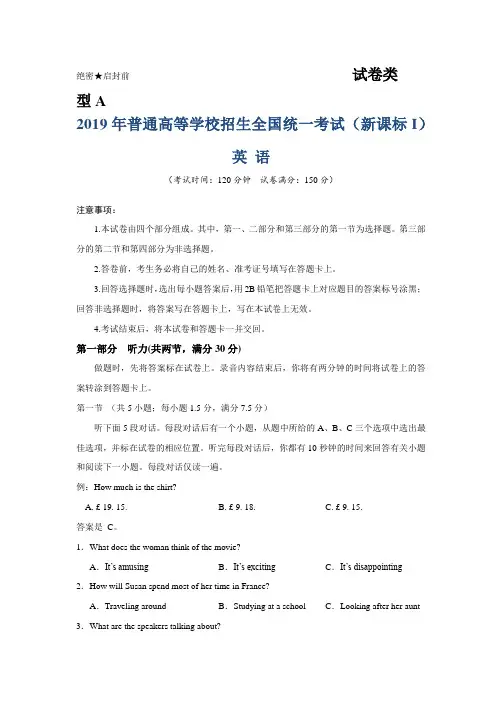
绝密★启封前试卷类型A2019年普通高等学校招生全国统一考试(新课标I)英语(考试时间:120分钟试卷满分:150分)注意事项:1.本试卷由四个部分组成。
其中,第一、二部分和第三部分的第一节为选择题。
第三部分的第二节和第四部分为非选择题。
2.答卷前,考生务必将自己的姓名、准考证号填写在答题卡上。
3.回答选择题时,选出每小题答案后,用2B铅笔把答题卡上对应题目的答案标号涂黑;回答非选择题时,将答案写在答题卡上,写在本试卷上无效。
4.考试结束后,将本试卷和答题卡一并交回。
第一部分听力(共两节,满分30分)做题时,先将答案标在试卷上。
录音内容结束后,你将有两分钟的时间将试卷上的答案转涂到答题卡上。
第一节(共5小题;每小题1.5分,满分7.5分)听下面5段对话。
每段对话后有一个小题,从题中所给的A、B、C三个选项中选出最佳选项,并标在试卷的相应位置。
听完每段对话后,你都有10秒钟的时间来回答有关小题和阅读下一小题。
每段对话仅读一遍。
例:How much is the shirt?A. £ 19. 15.B. £ 9. 18.C. £ 9. 15.答案是C。
1.What does the woman think of the movie?A.It’s amusing B.It’s exciting C.It’s disappointing 2.How will Susan spend most of her time in France?A.Traveling around B.Studying at a school C.Looking after her aunt 3.What are the speakers talking about?A.Going out B.Ordering drinks C.Preparing for a party 4.Where are the speakers?A.In a classroom B.In a library C.In a bookstore5.What is the man going to do?A.Go on the Internet B.Make a phone call C.Take a train trip第二节(共15小题;每小题1.5分,满分22.5分)听下面5段对话或独白。
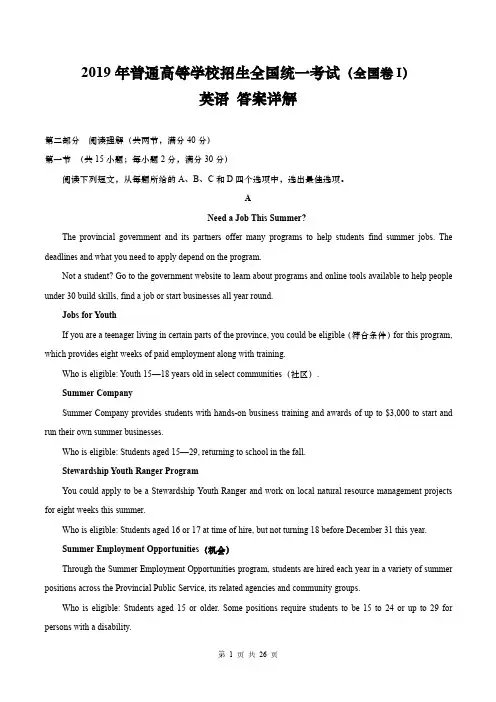
2019年普通高等学校招生全国统一考试(全国卷I)英语答案详解第二部分阅读理解(共两节,满分40分)第一节(共15小题;每小题2分,满分30分)阅读下列短文,从每题所给的A、B、C和D四个选项中,选出最佳选项。
ANeed a Job This Summer?The provincial government and its partners offer many programs to help students find summer jobs.The deadlines and what you need to apply depend on the program.Not a student?Go to the government website to learn about programs and online tools available to help people under30build skills,find a job or start businesses all year round.Jobs for YouthIf you are a teenager living in certain parts of the province,you could be eligible(符合条件)for this program, which provides eight weeks of paid employment along with training.Who is eligible:Youth15—18years old in select communities(社区).Summer CompanySummer Company provides students with hands-on business training and awards of up to$3,000to start and run their own summer businesses.Who is eligible:Students aged15—29,returning to school in the fall.Stewardship Youth Ranger ProgramYou could apply to be a Stewardship Youth Ranger and work on local natural resource management projects for eight weeks this summer.Who is eligible:Students aged16or17at time of hire,but not turning18before December31this year.Summer Employment Opportunities(机会)Through the Summer Employment Opportunities program,students are hired each year in a variety of summer positions across the Provincial Public Service,its related agencies and community groups.Who is eligible:Students aged15or older.Some positions require students to be15to24or up to29for persons with a disability.21.What is special about Summer Company?A.It requires no training before employment.B.It provides awards for running new businesses.C.It allows one to work in the natural environment.D.It offers more summer job opportunities.22.What is the age range required by Stewardship Youth Ranger Program?A.15—18.B.15—24.C.15—29.D.16—17.23.Which program favors the disabled?A.Jobs for Youth.B.Summer Company.C.Stewardship Youth Ranger Program.D.Summer Employment Opportunities.【解读】本文为应用文。
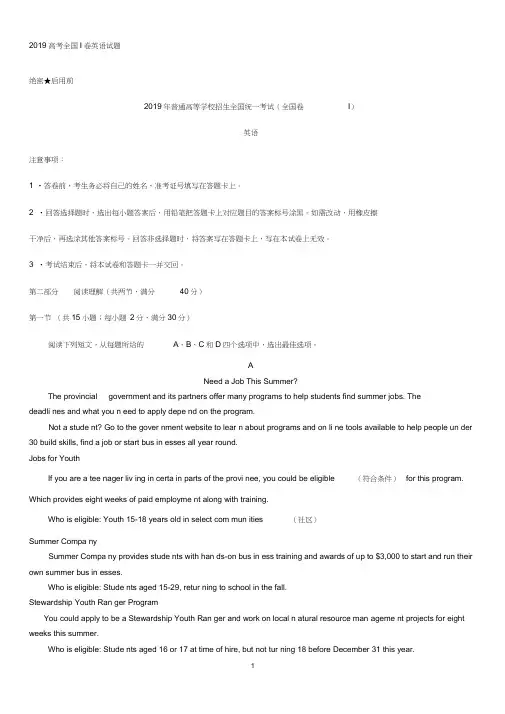
2019高考全国I卷英语试题绝密★启用前2019年普通高等学校招生全国统一考试(全国卷I)英语注意事项:1 •答卷前,考生务必将自己的姓名、准考证号填写在答题卡上。
2 •回答选择题时,选出每小题答案后,用铅笔把答题卡上对应题目的答案标号涂黑。
如需改动,用橡皮擦干净后,再选涂其他答案标号。
回答非选择题时,将答案写在答题卡上,写在本试卷上无效。
3 •考试结束后,将本试卷和答题卡一并交回。
第二部分阅读理解(共两节,满分40分)第一节(共15小题;每小题2分,满分30分)阅读下列短文,从每题所给的A、B、C和D四个选项中,选出最佳选项。
ANeed a Job This Summer?The provincial government and its partners offer many programs to help students find summer jobs. Thedeadli nes and what you n eed to apply depe nd on the program.Not a stude nt? Go to the gover nment website to lear n about programs and on li ne tools available to help people un der 30 build skills, find a job or start bus in esses all year round.Jobs for YouthIf you are a tee nager liv ing in certa in parts of the provi nee, you could be eligible (符合条件)for this program. Which provides eight weeks of paid employme nt along with training.Who is eligible: Youth 15-18 years old in select com mun ities (社区)Summer Compa nySummer Compa ny provides stude nts with han ds-on bus in ess training and awards of up to $3,000 to start and run their own summer bus in esses.Who is eligible: Stude nts aged 15-29, retur ning to school in the fall.Stewardship Youth Ran ger ProgramYou could apply to be a Stewardship Youth Ran ger and work on local n atural resource man ageme nt projects for eight weeks this summer.Who is eligible: Stude nts aged 16 or 17 at time of hire, but not tur ning 18 before December 31 this year.Summer Employme nt Opport un ities (机会)Through the Summer Employme nt Opport un ities program, stude nts are hired each year in a variety of summer positions across the Provincial Public Service, its related agencies and community groups.Who is eligible: Students aged 15 or older. Some positions require students to be 15 to 24 or up to 29 forpers ons with a disability.21. What is special about Summer Compa ny?A. It requires no training before employme nt.B. It provides awards for running new bus in esses.C. It allows one to work in the natural environment.D. It offers more summer job opport un ities.22. What is the age range required by Stewardship Youth Ran ger Program?A. 15-18.B.15-24.C.15-29.D.16-17.23. Which program favors the disabled?A. Jobs for Youth.B. Summer Compa ny.C. Stewardship Youth Ran ger Program.D. Summer Employme nt Opport un ities.BFor Canaan Elementary ' second grade in Patchogue, N.Y. , today is speech day ,and right now it ' ChrisPalaez ' s turn. The &ear-old is the joker of the class. With shining dark eyes, he seems like the of kid who would enjoy public speak ing.But he'snervous. "I 'here to tell you today why you should •…should …"Christrips on the -I d, ” a.pronunciation difficulty for many non-native English speakers. His teacher ,Thomas Whaley ,is next to him,whispering support. "•… Vote for •…me …" Except for some stumbles, Chris is doing amazingly well. When he brings his speech to a nice conclusion ,Whaley invites the rest of the class to praise him.A son of immigra nts, Chris stared lear ning En glish a little over three years ago. Whaley recalls (回想起)how at the beg inning of the year , when called upon to read , Chris would excuse himself to go to the bathroom.Lear ning En glish as a sec ond Ian guage can be a painful experie nee. What you n eed is a great teacher who letsyou make mistakes. " It takes a lot for any student ” Whaley explains , “ especially for a student who is learningEn glish as their new Ian guage , to feel con fide nt eno ugh to say , 'I don ' t kn,ovbut I want to know. '”Whaley got the idea of this sec on d-grade preside ntial campaig n project whe n he asked the childre n one day to raise their hands if they thought they could n ever be a preside nt. The an swer broke his heart. Whaley says the project is about more tha n just lear ning to read and speak in public. He wants these kids to lear n to boast (夸耀)about themselves.the classroom not feeli ng con fide nt.24. What made Chris nervous ?C. Spelli ng mistakes.D. Silly jokes.26. We can infer that the purpose of Whaley ' s project is to _______________A. help stude nts see their own stre ngthsB. assess stude nts ' public speak ing skillsC.prepare stude nts for their future jobs27. Which of the follow ing best describes Whaley as a teacher?As data and ide ntity theft becomes more and more com mon, the market is grow ing for biometric (生物测量)tech no logies — like fin gerpri nt sca ns— to keep others out of private e-spaces. At prese nt, these tech no logies are still expensive, though.Researchers from Georgia Tech say that they have come up with a low-cost device this problem: a smart keyboard. This smart keyboard precisely measures the cade nee(节奏) with which one typesand the pressure fin gers apply to each key. The keyboard could offer a strong layer of security by an alyz ing thingslike the force of a user's typing and the time betwee n key presses. These patter ns are unique to each pers on. Thus, the keyboard can determine people's identities, and by extension, whether they should be given access to the computer it's conn ected to — regardless of whether some one gets the password right.It also does n't require a new type of tech no logy that people aren't already familiar with. Everybody uses a keyboard and everybody types differe ntly.In a study describ ing the tech no logy, the researchers had 100 volun teers type the word “ touch ” fotimes using the smart keyboard. Data collected from the device could be used torecog nize differe nt participa nts basedon how they typed, with very low error rates. The researchers say that the keyboard should be pretty straightforward to commercialize and is mostly made of inexpensive, plastic-like parts. The team hopes to make it to market in the n ear future. 28. Why do the researchers develop the smart keyboard? A. To reduce pressure on keys. B. To improve accuracy in typ ing C. To replace the password system.D. To cut the cost of e-space protect ion.29. What makes the inven ti on of the smart keyboard possibleBoasting about yourself , and your best qualities,Whaley saysvery difficult for a child who came intoA. Telling a story. C. Taking a test.25. What does the un derl ined word B. Making a speech. D. An sweri ng a questio n. stumbles ” in paragraph 2 refer to?A. ImpropB. Bad manners.D. in spire stude nts 'love for politics A. Humorous. B. Ambitious.C. Caring. CD. Dema(装置) that gets aroundA. Computers are much easier to operate.B. Fin gerpri nt sca nning tech niq ues develop fast.C. Typing patter ns vary from pers on to pers on.D. Data security measures are guara nteed.30. What do the researchers expect of the smart keyboard ?During the rosy years of eleme ntary school(小学) ,1 enjoyed shari ng my dolls and jokes, which allowed meto keep my high social status. I was the quee n of the playgro und. Then came my twee ns and tee ns, and mean girlsand cool kids. They rose in the ranks not by being frien dly but by smok ing cigarettes, break ing rules and play ing jokes on others, among whom I soon found myself.Popularity is a well-explored subject in social psychology. Mitch Prinstein, a professor of clinical psychology sorts the popular into two categories: the likable and the status seekers. The likables plays -well-with-others qualities stre ngthe n schoolyard frien dships, jump-start in terpers onal skills and, whe n tapped early, are employed ever after in life and work. Then there ' s the kind of popularity that appears in adolesce nee: status born of powerand even disho no rable behavior.En viable as the cool kids may have seemed, Dr. Prin stein were highest in status in high school, as well as those least liked in eleme ntary school, are(从事) in dan gerous and risky behavior.”In one study, Dr. Prin ste in exam ined the two types of popularity in 235 adolesce nts, scori ng the least liked,the most liked and the highest in status based on stude nt surveys (调查研究) .“ We found that the least well-likedtee ns had become more aggressive over time toward their classmates. But so had those who were high in status. It clearly showed that while likability can lead to healthy adjustme nt, high status has just the opposite effect on us."Dr. Prinstein has also found that the qualities that made the neighbors want you on a play date -sharing, kindn ess, ope nn ess— carry over to later years and make you better able to relate and connect with others.In analyzing his and other research , Dr. Prinstein came to another conclusion: Not only is likability related to positive life outcomes, but it is also resp on sible for those outcomes, too. "Be ing liked creates opport un ities forlearning and for new kinds of life experie nces that help somebody gain an adva ntage, ” he said.32. What sort of girl was the author in her early years of eleme ntary school?33. What is the sec ond paragraph mainly about ? A. The classification of the popular. B. The characteristics of adolesce nts.A. It'll be environmen t-frie ndly. C. It'll be made of plastics.31. Where is this text most likely from? A. A diary.B.A guidebookB. It'll reach con sumers soon. D. It'll help speed up typing.C. A no vel.D. A magaz ine.Dmo sA. Unkind.B. Lon ely.C. Gen erous.D. Cool. sstudiesC. The importa nee of in terpers onal skills.D. The causes of dish ono rable behavior.34. What did Dr. Prinstein study find about the most liked kids?A. They appeared to be aggressive.B. They ten ded to be more adaptable.C. They enjoyed the highest status.D. They performed well academically.35. What is the best title for the text?A. Be Nice- You Won' t Finish Las tB. The Higher the Status, the BetterC. Be the Best-You Can Make ItD. More Self-C on trol, Less Aggressive ness第二节(共5小题;每小题2分,满分10分)根据短文内容,从短文后的选项中选出能填入空白处的最佳选项。
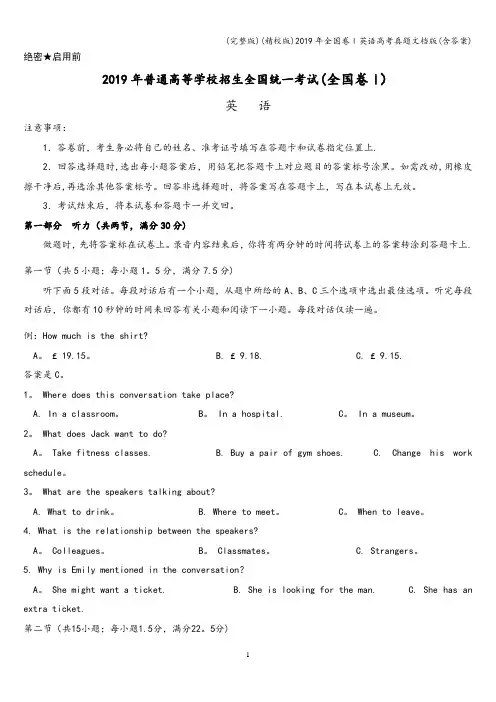
绝密★启用前2019年普通高等学校招生全国统一考试(全国卷I)英语注意事项:1.答卷前,考生务必将自己的姓名、准考证号填写在答题卡和试卷指定位置上.2.回答选择题时,选出每小题答案后,用铅笔把答题卡上对应题目的答案标号涂黑。
如需改动,用橡皮擦干净后,再选涂其他答案标号。
回答非选择题时,将答案写在答题卡上,写在本试卷上无效。
3.考试结束后,将本试卷和答题卡一并交回。
第一部分听力(共两节,满分30分)做题时,先将答案标在试卷上。
录音内容结束后,你将有两分钟的时间将试卷上的答案转涂到答题卡上.第一节(共5小题;每小题1。
5分,满分7.5分)听下面5段对话。
每段对话后有一个小题,从题中所给的A、B、C三个选项中选出最佳选项。
听完每段对话后,你都有10秒钟的时间来回答有关小题和阅读下一小题。
每段对话仅读一遍。
例:How much is the shirt?A。
£19.15。
B. £9.18. C. £9.15.答案是C。
1。
Where does this conversation take place?A. In a classroom。
B。
In a hospital. C。
In a museum。
2。
What does Jack want to do?A。
Take fitness classes. B. Buy a pair of gym shoes. C. Change his work schedule。
3。
What are the speakers talking about?A. What to drink。
B. Where to meet。
C。
When to leave。
4. What is the relationship between the speakers?A。
Colleagues。
B。
Classmates。
C. Strangers。
2019 年普通高等学校招生全国统一考试(全国卷1)英语注意事项:1.答卷前,考生务必将自己的姓名、考生号等填写在答题卡和试卷指定位置上。
2.回答选择题时,选出每小题答案后,用铅笔把答题卡上对应题目的答案标号涂黑。
如需改动,用橡皮擦干净后,再选涂其他答案标号。
回答非选择题时,将答案写在答题卡上,写在本试卷上无效。
3.考试结束后,将本试卷和答题卡一并交回。
第一部分听力(共两节,满分30 分)做题时,先将答案标在试卷上。
录音内容结束后,你将有两分钟的时间将试卷上的答案转涂到答题卡上。
第一节(共5 小题;每小题 1.5 分,满分7.5 分)听下面5 段对话。
每段对话后有一个小题,从题中所给的A、B、C 三个选项中选出最佳选项。
听完每段对话后,你都有10 秒钟的时间来回答有关小题和阅读下一小题。
每段对话仅读一遍。
例:How much is the shirt?A. £19.15.B. £9.18.C. £9.15.答案是C。
1.Where does this conversation take place?A. In a classroom.B. In a hospital.C. In a museum.2.What does Jack want to do?A.Take fitness classes.B.Buy a pair of gym shoes.C.Change his work schedule.3.What are the speakers talking about?A. What to drink.B. Where to meet.C. When to leave.4.What is the relationship between the speakers?A. Colleagues.B. Classmates.C. Strangers.5.Why is Emily mentioned in the conversation?A.She might want a ticket.B.She is looking for the man.C.She has an extra ticket.第二节(共15 小题;每小题1.5 分,满分22.5 分)听下面5 段对话或独白。
每段对话或独白后有几个小题,从题中所给的A、B、C 三个选项中选出最佳选项。
听每段对话或独白前,你将有时间阅读各个小题,每小题5 秒钟;听完后,各小题将给出5 秒钟的作答时间。
每段对话或独白读两遍。
听第6 段材料,回答第6、7 题。
6.How long did James run his business?A. 10 years.B. 13 years.C. 15 years.7.How does the woman feel about James’ situation?A. Embarrassed.B. Concerned.C. Disappointed.听第7 段材料,回答第8 至10 题。
8.What has Kate’s mother decided to do?A. Return to school.B. Change her job.C. Retire from work.9.What did Kate’s mother study at college?A. Oil painting.B. Art history.C. Business administration.10.What is Kate’s attitude toward her mother’s decision?A. Disapproving.B. Ambiguous.C. Understanding.听第8 段材料,回答第11 至13 题。
11.What is the man doing?A.Chairing a meeting.B.Hosting a radio program.C.Conducting a job interview.12.What benefits Mary most in her job?A. Her wide reading.B. Her leaders’ guidance.C. Her friends’ help.13.Who will Mary talk about next?A. Her teacher.B. Her father.C. Her mother.听第9 段材料,回答第14 至17 题。
14.Why does the man seldom do exercise?A. He lacks motivation.B. He has a heart problem.C. He works all the time.15.What does Jacob Sattelmair probably do?A. He’s an athlete.B. He’s a researcher.C. He’s a journalist.16.Why does the woman speak of a study?A.To encourage the man.B.To recommend an exercise.C.To support her findings.17.How much time will the man probably spend exercising weekly?A. 300 minutes.B. 150 minutes.C. 75 minutes.听第10 段材料,回答第18 至20 题。
18.What did the scientists do to the road?A. They repaired it.B. They painted it.C. They blocked it.19.Why are young birds drawn to the road surface?A. It’s warm.B. It’s brown.C. It’s smooth.20.What is the purpose of the scientists’ experiment?A.To keep the birds there for a whole year.B.To help students study the birds well.C.To prevent the birds from being killed.第二部分阅读理解(共两节,满分40 分)第一节(共15 小题;每小题 2 分,满分30 分)阅读下列短文,从每题所给的A、B、C 和D 四个选项中,选出最佳选项。
ANeed a Job This Summer?The provincial government and its partners offer many programs to help students find summer jobs. The deadlines and what you need to apply depend on the program.Not a student? Go to the government website to learn about programs and online tools available to help people under 30 build skills, find a job or start businesses all year round.Jobs for YouthIf you are a teenager living in certain parts of the province, you could be eligible (符合条件) for this program, which provides eight weeks of paid employment along with training.Who is eligible: Youth 15-18 years old in select communities (社区).Summer CompanySummer Company provides students with hands-on business training and awards of up to $3,000 to start and run their own summer businesses.Who is eligible: Students aged 15-29, returning to school in the fall.Stewardship Youth Ranger ProgramYou could apply to be a Stewardship Youth Ranger and work on local natural resource management projects for eight weeks this summer.Who is eligible: Students aged 16 or 17 at time of hire, but not turning 18 before December 31 this year.Summer Employment Opportunities (机会)Through the Summer Employment Opportunities program, students are hired each year in a variety of summer positions across the Provincial Public Service, its related agencies and community groups.Who is eligible: Students aged 15 or older. Some positions require students to be 15 to 24 or up to 29 for persons with a disability.21.What is special about Summer Company?A.It requires no training before employment.B.It provides awards for running new businesses.C.It allows one to work in the natural environment.D.It offers more summer job opportunities.22.What is the age range required by Stewardship Youth Ranger Program?A. 15-18.B. 15-24.C. 15-29.D. 16-17.23.Which program favors the disabled?A.Jobs for Youth.B.Summer Company.C.Stewardship Youth Ranger Program.D.Summer Employment Opportunities.BFor Canaan Elementary’s second grade in Patchogue, N.Y., today is speech day, and right now it’s Chris Palaez’s turn. The 8-year-old is the joker of the class. With shining dark eyes, he seems like the of kind of kid who would enjoy public speaking.But he’s nervous. “I’m here to tell you today why you should … should…” Chris trips on the “-ld,” a pronunciation difficulty for many non-native English speakers. His teacher, Thomas Whaley, is next to him, whispering support. “… Vote for … me …” Except for some stumbles, Chris is doing amazingly well. When he brings his speech to a nice conclusion, Whaley invites the rest of the class to praise him.A son of immigrants, Chris stared learning English a little over three years ago. Whaley recalls (回想起) how at the beginning of the year, when called upon to read, Chris would excuse himself to go to the bathroom.Learning English as a second language can be a painful experience. What you need is a great teacher who lets you make mistakes. “It takes a lot for any student,” Whaley explains, “especially for a student who is l earning English as their new language, to feel confident enough to say, ‘I don’t know, but I want to know.’”Whaley got the idea of this second-grade presidential campaign project when he asked the children one day to raise their hands if they thought they could never be a president. The answer broke his heart. Whaley says the project is about more than just learning to read and speak in public. He wants these kids to learn to boast (夸耀) about themselves.“Boasting about yourself, and your best qualities,” Whaley says, “is very difficult for a child who came into the classroom not feeling confident.”24.What made Chris nervous?A. Telling a story.B. Making a speech.C. Taking a test.D. Answering a question.25.What does the underlined word “stumbles” in paragraph 2 refer to?A. Improper pauses.B. Bad manners.C. Spelling mistakes.D. Silly jokes.26.We can infer that the purpose of Whaley’s project is to .A.help students see their own strengthsB.assess students’ public speaking skillsC.prepare students for their future jobsD.inspire students’ love for politics27.Which of the following best describes Whaley as a teacher?A. Humorous.B. Ambitious.C. Caring.D. Demanding.CAs data and identity theft becomes more and more common, the market is growing for biometric ( 生物测量) technologies — like fingerprint scans — to keep others out of private e-spaces. At present, these technologies are still expensive, though.Researchers from Georgia Tech say that they have come up with a low-cost device ( 装置) that gets around this problem: a smart keyboard. This smart keyboard precisely measures the cadence ( 节奏) with which one types and the pressure fingers apply to each key. The keyboard could offer a strong layer of security by analyzing things like the force of a user’s typing and the time between key presses. These patterns are unique to each person. Thus, the keyboard can determine people’s identities, and by extension, whether they should be given access to the computer it’s connected to — regardless of whether someone gets the password right.It also doesn’t require a new type of technology that people aren’t already familiar with. Everybody uses a keyboard and everybody types differently.In a study describing the technology, the researchers had 100 volunteers type the word “touch” four times using the smart keyboard. Data collected from the device could be used to recognize different participants based on how they typed, with very low error rates. The researchers say that the keyboard should be pretty straightforward to commercialize and is mostly made of inexpensive, plastic-like parts. The team hopes to make it to market in the near future.28.Why do the researchers develop the smart keyboard?A. To reduce pressure on keys.B. To improve accuracy in typing.C. To replace the password system.D. To cut the cost of e-space protection.29.What makes the invention of the smart keyboard possible?puters are much easier to operate.B.Fingerprint scanning techniques develop fast.C.Typing patterns vary from person to person.D.Data security measures are guaranteed.30.What do the researchers expect of the smart keyboard?A. It’ll be environment-friendly.B. It’ll reach consumers soon.C. It’ll be made of plastics.D. It’ll help speed up typing.31.Where is this text most likely from?A. A diary.B. A guidebook.C. A novel.D. A magazine.DDuring the rosy years of elementary school ( 小学), I enjoyed sharing my dolls and jokes, which allowed me to keep my high social status. I was the queen of the playground. Then came my tweens and teens, and mean girls and cool kids. They rose in the ranks not by being friendlybut by smoking cigarettes, breaking rules and playing jokes on others, among whom I soon found myself.Popularity is a well-explored subject in social psychology. Mitch Prinstein, a professor of clinical psychology sorts the popular into two categories: the likable and the status seekers. The likables’plays-well-with-others qualities strengthen schoolyard friendships, jump-start interpe rsonal skills and, when tapped early, are employed ever after in life and work. Then there’s the kind of popularity that appears in adolescence: status born of power and even dishonorable behavior.Enviable as the cool kids may have seemed, Dr. Prinstein’s studies show unpleasant consequences. Those who were highest in status in high school, as well as those least liked in elementary school, are “most likely to engage (从事) in dangerous and risky behavior.”In one study, Dr. Prinstein examined the two types of popularity in 235 adolescents, scoring the least liked, the most liked and the highest in status based on student surveys (调查研究). “We found that the least well-liked teens had become more aggressive over time toward their classmates. But so had those who were high in status. It clearly showed that while likability can lead to healthy adjustment, high status has just the opposite effect on us.”Dr. Prinstein has also found that the qualities that made the neighbors want you on a play date — sharing, kindness, openness — carry over to later years and make you better able to relate and connect with others.In analyzing his and other research, Dr. Prinstein came to another conclusion: Not only is likability related to positive life outcomes, but it is also responsible for those outcomes, too. “Being liked creates opportunities for learning and for new kinds of life experiences that help somebody gain an advantage, ” he said.32.What sort of girl was the author in her early years of elementary school?A. Unkind.B. Lonely.C. Generous.D. Cool.33.What is the second paragraph mainly about?A. The classification of the popular.B. The characteristics of adolescents.C. The importance of interpersonal skills.D. The causes of dishonorable behavior.34.What did Dr. Prinstein’s study find about the most liked kids?A. They appeared to be aggressive.B. They tended to be more adaptable.C. They enjoyed the highest status.D. They performed well academically.35.What is the best title for the text?A. Be Nice —You Won’t Finish LastB. The Higher the Status, the BetterC. Be the Best — You Can Make ItD. More Self-Control, Less Aggressiveness第二节(共5 小题;每小题 2 分,满分10 分)根据短文内容,从短文后的选项中选出能填入空白处的最佳选项。